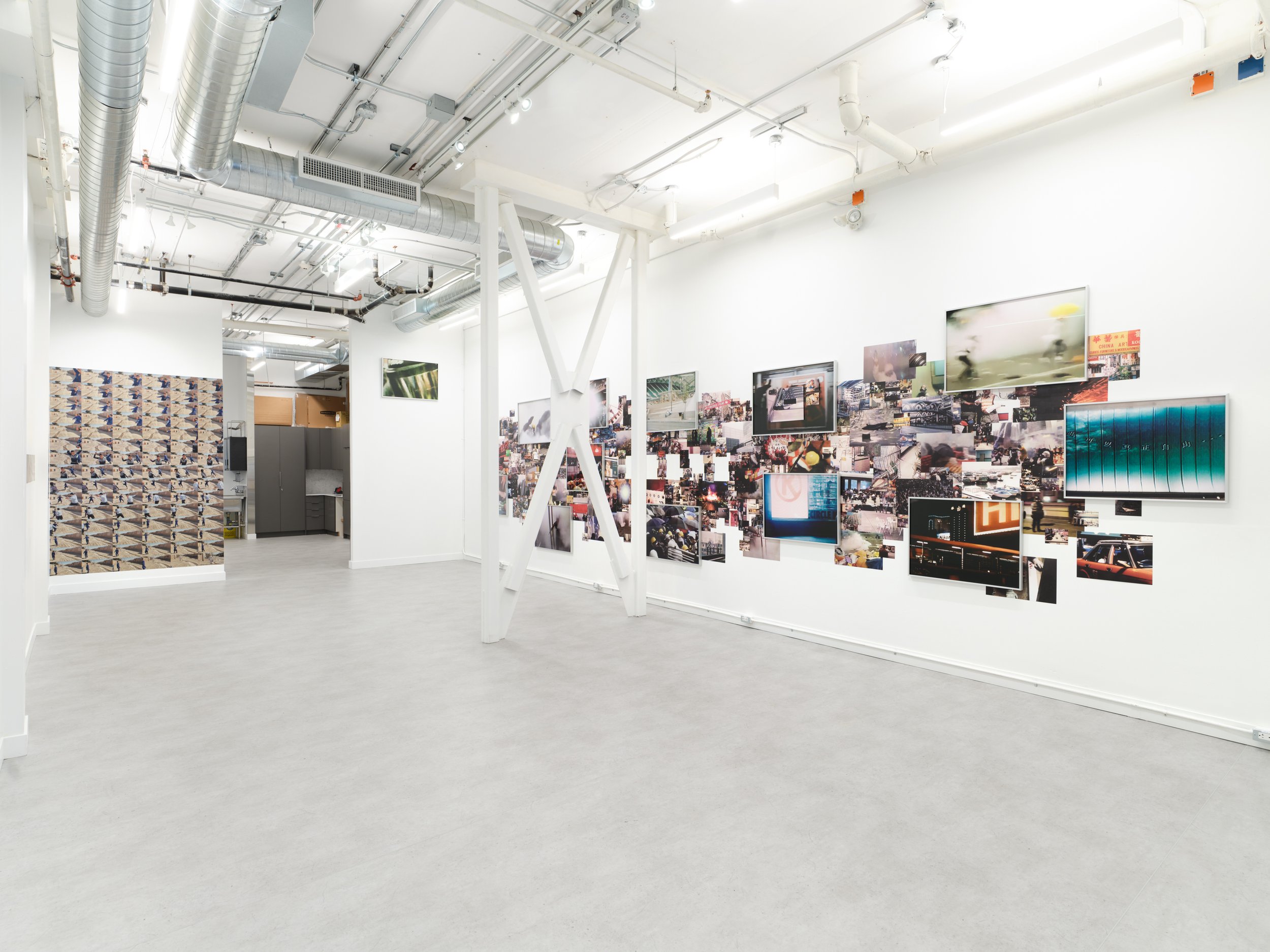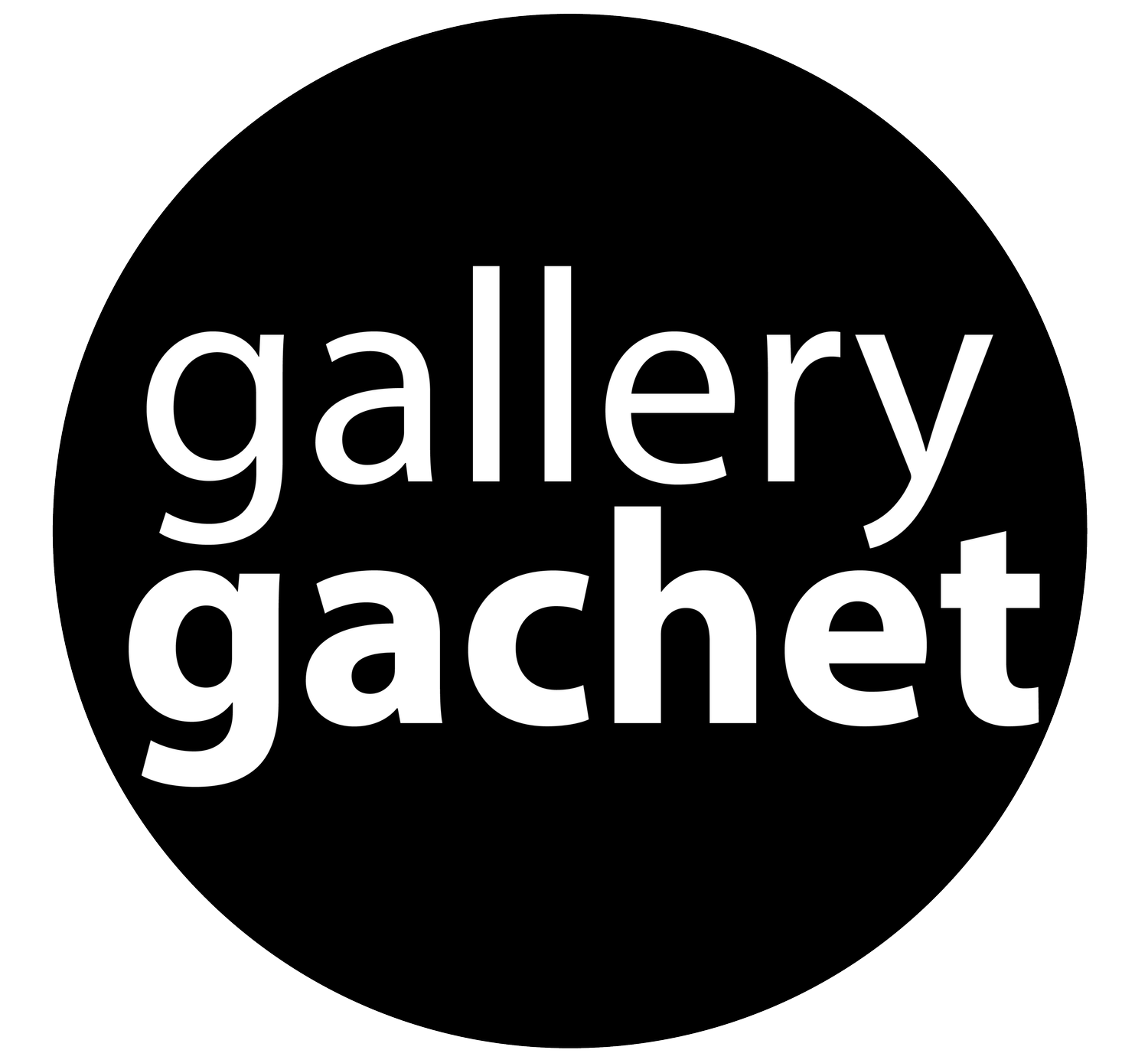An Injury On the Diasporic Imagination: Chad Wong & Pegah Tabassinejad
Pegah Tabassinejad, 0503233, inkjet print on vinyl, dimensions variable
May 8, 2025–June 20, 2025
“The homeland is no longer a dwelling. Instead, the diaspora dwells in the signs of belonging and the simulacra of memory.”
—Homi Bhabha
An Injury On the Diasporic Imagination foregrounds the transactional nature of citizenship and movement, the politics of diasporic belonging, and the fractured ways in which images and memories of landscapes, people, and moments of societal rupture are formed and proliferated in a world shaped by the domineering presence of surveillance and digital culture.
Through aesthetic techniques rooted in digital and surveillance media—including glitch, repetition, redaction, and the pervasiveness of the illegible image—exhibiting artists Chad Wong and Pegah Tabassinejad explore the dual function of surveillance imagery as both a tool of oppression and a means of bearing witness, documenting place, and reasserting one’s humanity.
In the hands of Tabassinejad and Wong, these images embody an ongoing negotiation of diasporic identity, alluding to the responsibilities that individuals across the diaspora carry in their remembrance and perception of place, and the gestures of active solidarity that might be enacted in moments of upheaval in the places they call home.
The “injury” then , refers to the wound inflicted on both the collective and individual psyche during these moments of disruption—wounds that provoke deeper questions around home, identity, and what it means to be a body dislocated, in transit, or unmoored.
Olumoroti George
Director/Curator






















About the Artists
Chad Wong is a lens based visual artist residing in the unceded traditional territories of the xʷməθkʷəy ̓ əm (Musqueam), Sḵwx ̱ wú7mesh (Squamish), and səlilwətaɬ (Tsleil-Waututh) Nations also known as Vancouver, British Columbia. Born in 1993, Wong received his Bachelor of Fine Arts from the University of British Columbia in 2016.
His exhibitions include “我住喺呢度嘅!/I live here!” which was part of Capture Photography Festival 2024, "Empty Spaces that Fill My Heart" at Aberdeen Skytrain Station (2022) and “Ma Fan Cafe” at the Richmond Art Columns organized by Richmond Art Gallery. His photographs have been featured in C-Mag and Broad Magazine. Wong's work primarily explores the evolving cultural landscapes of the Hong Kong-Chinese-Canadian diaspora, capturing the intricate connections between identity, memory and space.
Pegah Tabassinejad is an interdisciplinary artist and educator originally from Iran who is living and working on the traditional, ancestral, and unceded territories of the xwməθkwəy̓ əm, Sḵwx̱ wú7mesh, and Sel̓ íl̓ witulh peoples.
Tabassinejad's new media practice primarily revolves around the construction of digital and live performances, film, video installations and city projects. Her practice acts as an interrogation on themes that include the intersection of digital and surveillance culture on identity, virtual and physical presences and absences, and the forces that structure and shape the movement and perception of marginalized and female bodies in private and public space.
Tabassinejad holds an MFA in Interdisciplinary Art from Simon Fraser University and a BA in Stage Direction from the Tehran University of Art. She also studied Visual Art at Azad University in Tehran. She has taught various studio and seminar courses at the Tehran University of Art, Bamdad International House, Barg Institute, and Kwantlen Polytechnic University. She was the recipient of the Phil Lind Multicultural Artist Residency at UBC in 2023–2024.
Her projects have been shown locally and internationally. Her latest eight-channel video installation, Entropic Fields of Displacement, premiered in Vancouver at VIVO Media Arts and in Amsterdam at the International Documentary Film Festival Amsterdam in 2024, and won the prestigious IDFA Award in digital storytelling.
Outro
Gloria Wong on Chad Wong
“I am already homesick for Hong Kong...The ubiquitous and mimetic image of Hong Kong only furnishes the tantalizing illusion that the place exists in this nearness; and consuming these images, it is as if this nostalgia will never entirely be my own for a city that exists less and less like the place I know it to be.”
— Tiffany Sia, Too Salty, Too Wet 更咸更濕
In “Glitch is Remix”, chapter 11 of her landmark 2020 manifesto Glitch Feminism, Legacy Russell positions glitch in its remix as “an act of self determination...a technology of survival”. (Russell, p. 95) Glitch offers a space of possibility for peoples who have historically been marginalized to rearrange, reclaim and remix from what is already there, a notion taken up by artist Chad Wong in An Injury on the Diasporic Imagination.
For Wong, glitch as remix becomes a framework through which he negotiates his identity as a diasporic artist from Hong Kong, in the wake of the 2019 protests. Borrowing from the aesthetics and strategies of digital culture, surveillance and nostalgia media, his work grapples with memory, distance, belonging and refusal while navigating moments of rupture and upheaval in his home city.
—
1997, 2047. Hong Kong’s expiry date was decided a year before I was born. I am already homesick for Hong Kong.
What does it mean to be homesick for a place you never knew? How do we bear witness to an anticipatory loss?
—
The sprawling, expansive photographic installation 我住喺呢度嘅!/I live here! (2023)/回不到的家是最美麗的 / The Home That I Cannot Return To Is the Most Beautiful (2024) unravels across the length of a wall in the gallery, juxtaposing images from the 2019 Hong Kong protests with stills from a sitcom popular during the artist’s childhood. Collapsing multilayered histories and references into the installation, Wong punctuates the spectacle of protest imagery with quiet moments depicting mahjong games, fruit stalls, cha chaan tengs and cityscapes. Watching the uprisings of 2019 unfold from overseas through livestreams, news channels and Instagram videos, Wong’s installation questions what it means to bear witness, untangling the complicated relationship between those in the diaspora to their homelands. Re-photographed by the artist through a screen, glitch becomes a defining element of the work. The images here are marked by a layer of illegibility, filtered through distortion, textures and moiré. In refusing any easy access to the photographs, Wong emphasizes the distance felt between the viewer, the artist and the scenes depicted.
Tucked away in a quiet alcove in the gallery is a small CRT TV with the video work 希望在明天 / There Is Hope in Tomorrow playing. A remix of a 1998 state-sanctioned PSA, Wong’s video slows, loops and distorts the titular slogan, “希望在明天 / There is Hope in Tomorrow”, transforming the traditionally optimistic words into a sardonic, haunting repetition. With the widening censorship and crackdown on protests across Hong Kong, Wong’s intervention uses nostalgia as a strategy to echo the disillusionment felt across the city and contend with the sense of loss felt across generations, at home and abroad.
In Wong’s hands, Hong Kong becomes a cyborg. Synthesized from an assemblage of digital culture, protests, nostalgia, cityscapes and everyday life, he attempts to make sense of Hong Kong’s identity and culture through the glitch, remixing, rearranging and re-presenting the city, with all of its fractures and ruptures. For Wong, reckoning with the looming date of 2047, perhaps what the glitch also offers here is a form of memorialization, a way to remember the home that he cannot return to.
—
2047 is now 22 years away and I am already homesick for Hong Kong.
Gloria Wong
About The Writer
Gloria Wong (b. 1998) is a visual artist based between Tkaronto/Toronto and Vancouver, on the unceded territories of the xwməθkwəy̓əm (Musqueam), Sḵwx̱wú7mesh (Squamish), and Sel̓íl̓witulh (Tsleil-Waututh) Nations. Her work explores the complexities and nuances of Asian diasporic identities and how they are shaped by different relationships — between people, their environments or objects. Through her lens-based practice, she is interested in the ways that this identity and lineage is constructed, negotiated and documented through embodied acts of care, memory and gesture. Recent exhibitions include solo exhibitions at Or Gallery and Micki Meng Gallery and group exhibitions at the plumb, United Contemporary, the Cantor Arts Center, Pendulum Gallery, Burrard Arts Foundation and The Polygon Gallery. Wong holds a BFA in Photography from Emily Carr University of Arts + Design and is currently the Communications + Community Outreach Coordinator at Gallery TPW.
Artist Talk: Saturday May 31st, 2025 4–6PM
With exhibiting artists Pegah Tabassinejad and Chad Wong in conversation with Director/Curator Olumoroti George
Film Screening: June 5th: 6:00–8:30 PM
As a part of our An Injury On the Diasporic Imagination exhibition programming, join us June 5th from 6:00-8:30 PM for a special feature screening of My Stolen Planet (2024) directed by Farahnaz Sharifi. The evening will begin with an excerpt reading by exhibiting artist, Chad Wong, from Tiffany Sia's book Too Salty Too Wet, and the film will begin promptly at 6:30 PM and conclude with an open group discussion.
“‘My Stolen Planet’ is a diary-style narrative by Farah, an Iranian filmmaker. Born during the Islamic revolution in Iran in 1979, she captures moments of joy and defiance in her daily life, navigating the contrast between domestic freedom and external oppression. Simultaneously, she collects 8mm archives from people she doesn't know. Relying on others' recordings, she gains a new perspective on losing memories. Her connection with Leyla, an Iranian professor who left Iran during the revolution, adds a name and story to one of her archive's faces. Farah's mother, suffering from Alzheimer's, motivates her to fight against forgetting. In the fall of 2022, the Women, Life, Freedom uprising became a turning point in Farah's life, as well as in the lives of many others in Iran. This is a homemade history.”
Please RSVP here: https://form.jotform.com/251487796852273

